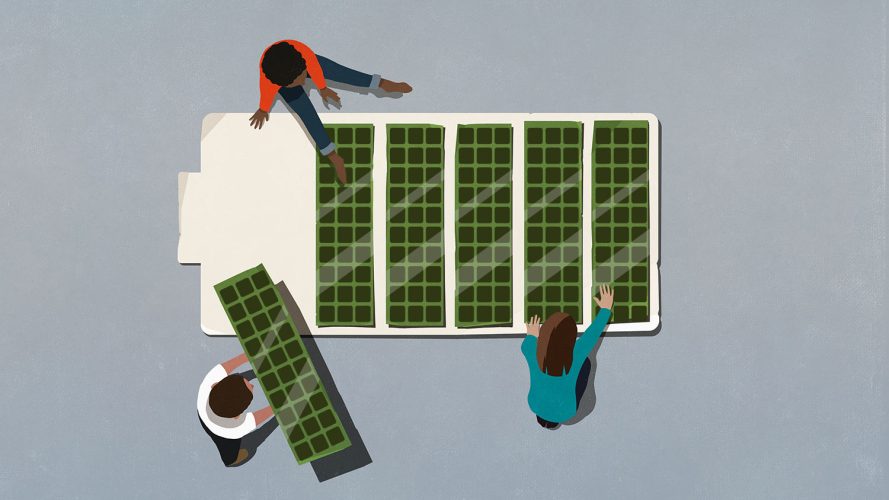Utility Customers Are Generating Their Own Power — Embrace the New Opportunities



Both sides benefit when customers become suppliers. Utilities are using this shift to increase lifetime customer value and create new revenue streams.
As more consumers start generating and storing their own electricity, they are creating a new energy economy with benefits and opportunities for electric utilities. Utilities can use this change to build trusted relationships and collaborate with customers on decarbonization efforts. No longer just a one-way relationship, the new utility-customer partnership helps us work together toward a more resilient grid and makes utilities more valuable than ever.
What is a prosumer?
In the utility space, an “energy prosumer” is a customer who generates their own power. They invest in their own distributed energy resources (DERs), like solar, wind, or battery storage. Then they can sell the excess energy they produce back to the utility. Prosumers are forward-thinking energy customers who lean into efficiency and decarbonization. Newly empowered in every sense of the word, prosumers now influence the design and creation of new utility services and products.
Utilities can take part in this new power dynamic by cultivating their relationship with prosumers. DERs help a utility meet its net zero decarbonization goals and create a more resilient power grid. The grid may not be ready (yet) for the influx of prosumers we’re seeing today, but the transition is happening. Many utilities see this shift as an opportunity to increase lifetime customer value and create new revenue streams. Ultimately, both sides benefit when customers become suppliers.
Transform your customer relationship
Here’s how you can use technology to deliver new programs faster and cheaper and keep up with customer expectations.



How can utilities work with energy prosumers?
Educating and engaging prosumers will be vital to the energy transition. To engage customers as partners who contribute to resiliency and sustainability, utilities use incentive programs and data transparency to nudge their behavior.
Incentives like energy efficiency and demand response programs have existed for decades, and are now even more important as consumers have more capacity to manage their own energy and generate clean electricity themselves. In these “demand side management” (DSM) programs, utilities explain to residential and commercial and industrial (C&I) customers how their DERs and consumption patterns impact the grid. Utilities will often pay incentives for shifting usage to “off-peak” times. Participating customers can then dial their own usage up or down to help utilities manage load (demand on the grid).
Utilities also have more ability today to share tools and large amounts of data with customers in real time. When this data transparency is paired with education and advice, it is a powerful tool for creating shared value and partnership on the journey to net zero. Online calculators are one way that customers and utilities can share information to work together to save energy. For example, a calculator can model the potential cost savings of electrifying a fleet of vehicles, and how much a business can benefit from charging them during off-peak times.
These strategies build upon tactics that utilities have used for decades. Today, with more data and digital processes available, we can do even more. A growing number of C&I companies are leaning hard into net zero goals and asking their energy suppliers for help. They want new options, including green tariffs and emission avoidance. They embrace clean energy policies that encourage the transition to renewables. Working together, utilities and customers can create high-impact renewable options and work toward decarbonization.
This is especially important as more regulators consider asking utilities to shift from asset-based to performance-based revenue models. As the Rocky Mountain Institute explains, performance-based regulation (PBR) “is an approach to regulating electric utilities that aims to align a utility’s profit motives with societal goals, such as decarbonization and resilience. Broadly speaking, PBR provides an alternative to the traditional ‘cost of service’ regulation by compensating utilities for how they perform rather than for selling more electricity or making new infrastructure investments.”
If utilities can profit from providing energy services and not just by building more power generation assets, they will promote more energy efficiency and energy management programs that benefit all customers.
Understanding energy prosumer goals
Business prosumers exert more impact than ever on grid infrastructure and energy supply and demand. That makes it important to understand their goals to work with them effectively. C&I utility customers are already interested in optimizing their energy consumption and meeting environmental, social and governance (ESG) goals. This makes them powerful allies in the development and management of a cleaner grid.
C&I businesses want to achieve net zero commitments, but they also want to recoup their investment by selling the energy they generate. This creates opportunities to collaborate with utilities. Take this example of managing the growing number of electric vehicle (EV) fleets: EVs can provide businesses with an alternative revenue stream by selling the stored energy from car batteries back to the utility when energy demand is high. The result is the company generates passive income from EVs when they aren’t in use. By creating more of these win-win relationships, utilities can offer new green programs that excite their customers.
An essential resource for a partnership with the energy prosumer is the customer usage data collected by advanced metering infrastructure (AMI). AMI data helps customers decide how to manage their electricity, use new products, or enable third-party services. Data analytics can help every customer understand their own consumption patterns and make changes in line with their own needs and motivations. Sharing data and usage insights with customers helps change their relationships with the utility from a mere consumer to more of a partner. As a partner, customers can adjust their energy consumption in ways that support grid conditions and keep the lights on.
Data transparency builds customer trust and makes it easier to work together. For example, some utilities have developed easy-access portals to help customers quickly connect their own renewables to the larger grid. These portals give the utility real-time insight into the status of customer applications and the engineering calculations associated with their connection requests. Here’s another example: if a utility needs to resort to brownouts on hot days in California’s fire season, it helps to show customers why. Also, some regional independent system operators provide grid and market conditions data in real time. This is the stuff of dreams for facility managers who are optimizing cost and energy usage at C&I sites. The point is to build trust rather than what customers can perceive as blockades.
More possibilities open up when the energy prosumer works directly with utilities. Customers should (but many don’t) consult with utilities before making fleet purchasing decisions, installing solar arrays, or designing microgrids on a customer site. These initiatives all have a big impact on grid planning. Utilities can benefit from building partnerships around these projects rather than working through third parties. Some utilities have been proactive in encouraging EV adoption because beneficial electrification helps achieve multilevel net zero goals — for states, municipalities, companies, and utilities.
Fleet electrification and EV adoption pose a new challenge as the stakeholders involved in these projects go beyond just the utilities and customers. Auto dealers, auto makers, property owners and fleet leasing companies, EV charging manufacturers, and municipalities are also part of the conversation. How can we coordinate the whole supply chain around a vehicle and driver to create energy efficiency and clean fuel choices? In these situations, utilities can encourage inclusive partnership strategies for both residential and business customers. It’s possible to work with the stakeholder to offer compelling value propositions to business customers and make the case for electrifying fleets.
Looking to the future of energy prosumer relationships
The energy prosumer is already having an impact on utilities. Some utilities have even changed their load growth planning to factor in the energy that prosumers now generate. C&I leaders are also influencing how utilities handle their data. Predictive analyses supplied by utilities help C&I businesses weigh the costs and benefits of investments — like onsite power generation or battery storage — that get them to net zero faster. More utilities are adopting a purpose-built platform to quickly deliver the data C&I companies need to create comprehensive, accurate reports to their customers, regulators, and stakeholders.
Grid infrastructure and utility revenue models will keep evolving. Regulators are expanding goals to include grid resilience and performance-based revenue models. Companies that are used to engaging directly with consumers — like manufacturers and suppliers of batteries, solar services, heat pumps, home charging, and even automakers — are entering the ecosystem to deliver energy benefits. And utilities that advocate for decarbonization are supporting them. How will everyone keep the customer at the center of all this, in real time? With data and accessible platforms that build trust and agility.
Understand the prosumer relationship
Learn more about managing customer relationships and uncover new opportunities for expanding services and increasing revenue.
















